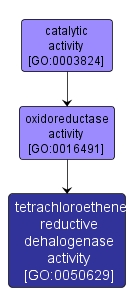GO TERM SUMMARY
|
| Name: |
tetrachloroethene reductive dehalogenase activity |
| Acc: |
GO:0050629 |
| Aspect: |
Molecular Function |
| Desc: |
Catalysis of the reaction: trichloroethene + chloride + acceptor = tetrachloroethene + reduced acceptor. |
Synonyms:
- tetrachloroethene reductase activity
- acceptor:trichloroethene oxidoreductase (chlorinating)
|
|

|
INTERACTIVE GO GRAPH
|














